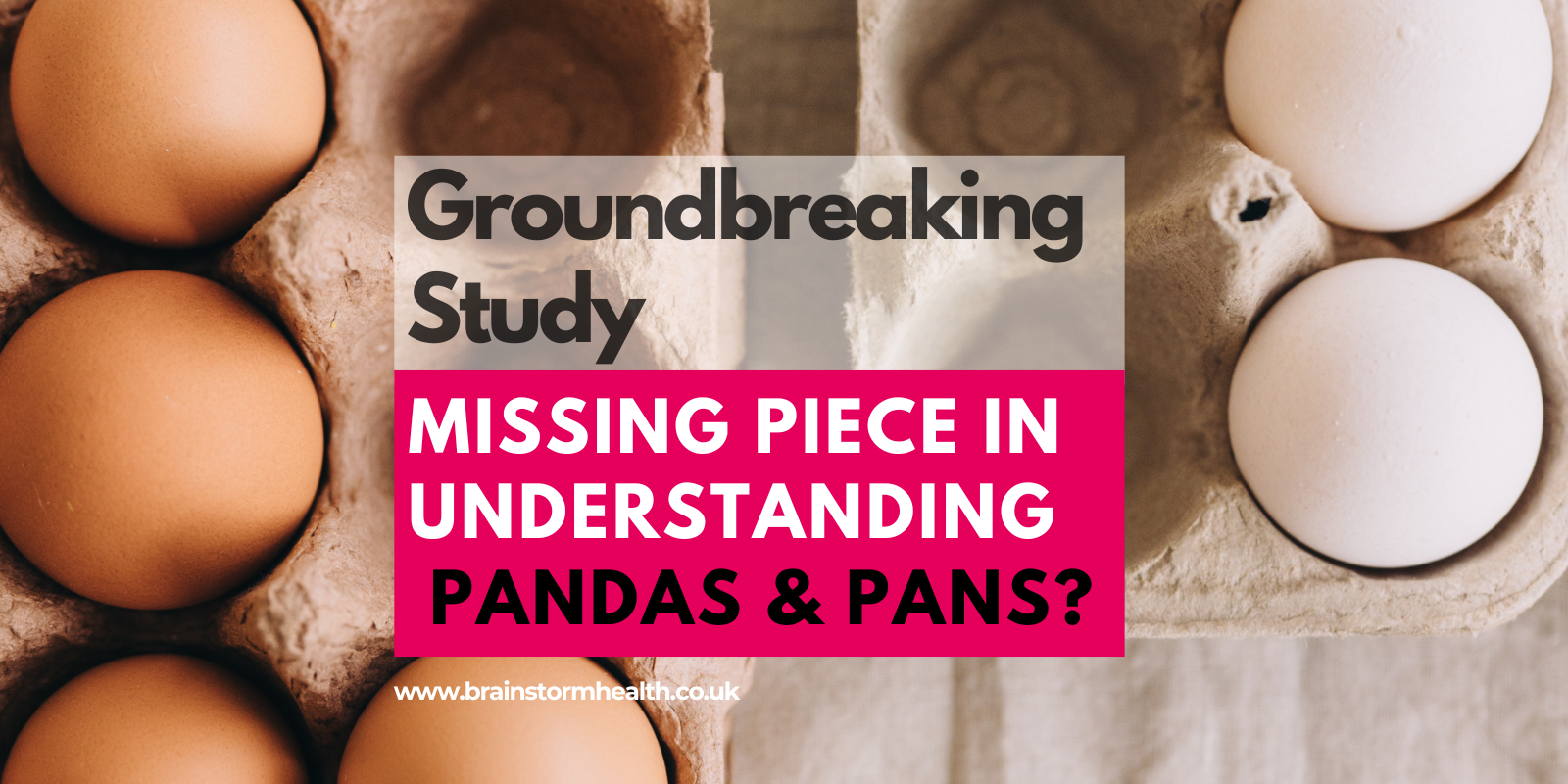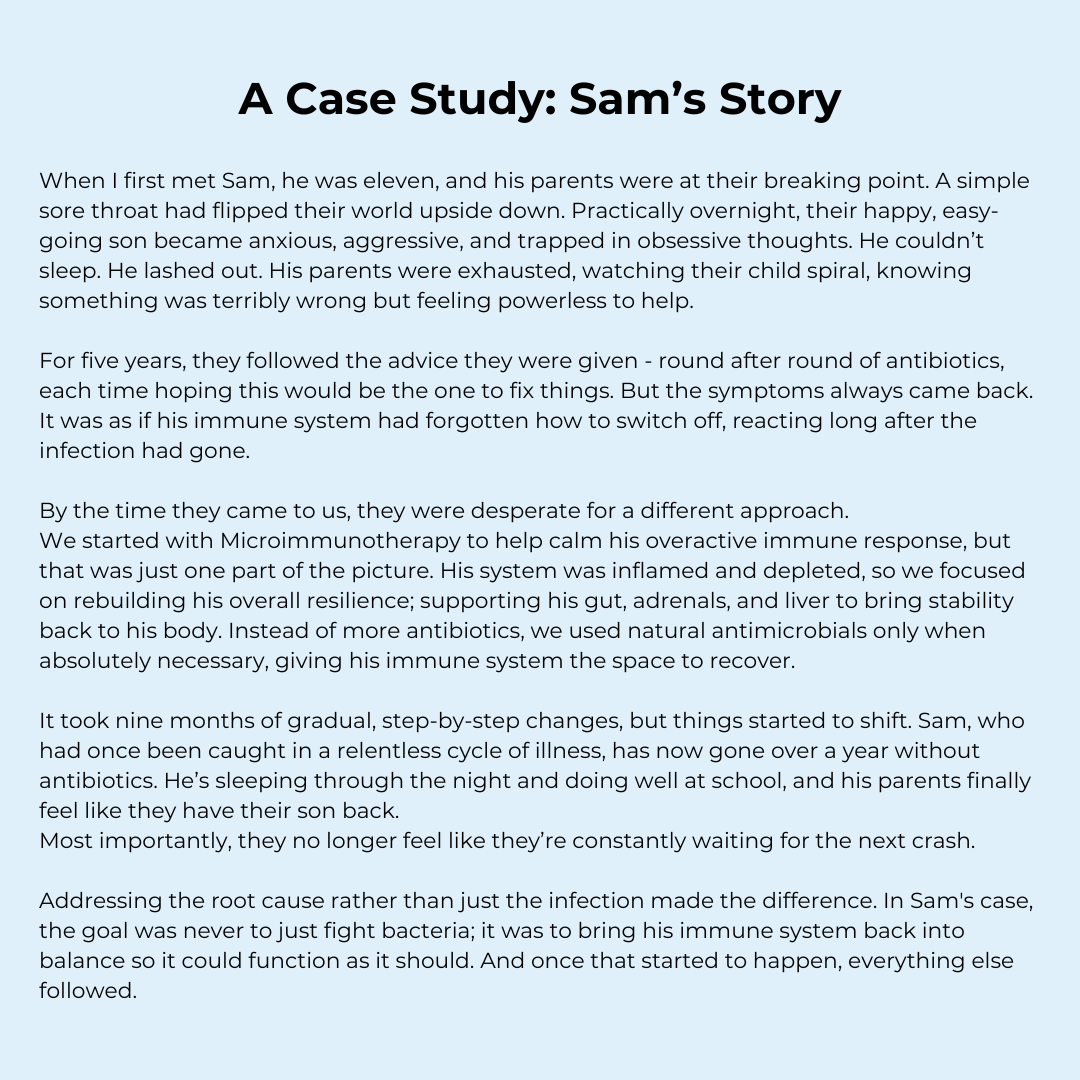The Missing Piece in Understanding PANDAS and PANS?
What If Everything We Thought About PANDAS Was Wrong?
For years, scientists have debated how infections can trigger autoimmune diseases and neuroimmune disorders. The most widely accepted theory has been molecular mimicry, the idea that certain bacteria and viruses resemble human cells so closely that the immune system gets confused and attacks the wrong target.
But what if that’s not actually what’s happening?
A study from the Garvan Institute in Australia challenges this idea. Instead of tricking the immune system, infections appear to push it into overdrive, creating rogue immune cells that continue attacking long after the infection is gone.
This could change how we understand both PANDAS and PANS, conditions where children suddenly develop symptoms like OCD, tics, anxiety, mood disturbances, and urinary frequency following an infection. While PANDAS is specifically linked to streptococcal infections, PANS can be triggered by a variety of infectious and environmental factors. If rogue B cells are involved, then these conditions may not be purely autoimmune in the traditional sense but rather a case of an immune system that has lost its ability to regulate itself properly.
However, it’s important to acknowledge that the Garvan study focused on hepatitis C-related cryoglobulinemic vasculitis, not PANDAS, PANS, or neurological conditions. While the study provides an interesting parallel, it does not directly prove the same rogue B cell mechanism is at play in these disorders. That said, it offers a crucial insight into how infections can drive long-term immune dysfunction, showing that even when the initial infection is cleared, the immune system may continue attacking the body. More research is needed to understand the full scope of immune dysfunction in PANDAS and PANS.
The Immune System as a Training Camp
B cells are like soldiers trained to fight infections. Normally, once the battle is won, most are dismissed, leaving behind a small, well-prepared reserve.
But what if the training never stops?
Instead of standing down, the immune system keeps pushing B cells through unnecessary training rounds. Some mutate into rogue fighters, attacking not just infections but the body itself.
This isn’t confusion. The immune system isn’t mistaking the body for strep. It is creating a new kind of attacker, one that no longer needs strep or other pathogen to keep causing harm.
This may explain why some children respond to treatments like IVIG and rituximab, which attempt to reset the immune response. IVIG floods the body with donor antibodies, helping to regulate immune activity and reduce inflammation. Rituximab goes even further, wiping out B cells entirely to eliminate the rogue ones.
These treatments can be effective, but they don’t always provide lasting relief. If the immune system remains stuck in this cycle, new rogue B cells may continue to emerge, which could explain why some children relapse even after initially responding to therapy.
What the Study Found and Why It Matters
The Garvan Institute study looked at patients with hepatitis C who developed cryoglobulinemic vasculitis, a condition where rogue B cells produce harmful autoantibodies. Researchers found:
B cell clones persisted even after the virus was eliminated
These clones had accumulated thousands of mutations, making them more aggressive
Instead of targeting the virus, they adapted to attack human tissue
There was no evidence of molecular mimicry. The immune system wasn’t making a mistake. Instead, it had been pushed into a chronic state of activation, allowing rogue B cells to persist and cause ongoing damage.
Another Perspective: Dr. Dritan Agalliu’s Research
While the Garvan study focuses on rogue B cells, another important theory comes from Dr. Dritan Agalliu at Columbia University. His research suggests that PANDAS symptoms stem from blood-brain barrier breakdown, allowing immune cells to infiltrate the brain and trigger neurological symptoms.
Dr. Agalliu’s findings show that:
Repeated strep infections recruit Th17 immune cells, which target the blood-brain barrier
These immune cells weaken the barrier, allowing antibodies and inflammation to enter the brain
This may trigger the sudden onset of OCD, tics, and anxiety seen in PANDAS
Rather than rogue B cells running wild, Agalliu’s work highlights how repeated infections may weaken the brain’s defences, making it vulnerable to immune attacks.
So which explanation is correct? It may not be one or the other. PANDAS could involve both mechanisms or different children may experience different pathways to the same symptoms.
Why Do Some Children Develop PANDAS While Others Recover?
Not every child who gets strep develops PANDAS. So why does it happen to some but not others? The answer likely lies in genetics, immune function, and environmental stressors- factors that shape how the body responds to infections.
The Role of Genetics
Genetic susceptibility doesn’t cause PANDAS or PANS outright, but it may determine how the immune system responds to infections. Some children inherit a tendency for prolonged immune activation, making them more vulnerable when faced with stressors like gut dysbiosis, chronic inflammation, or toxin exposure.
Some children are more vulnerable to prolonged immune activation. While a family history of autoimmunity can play a role, it isn’t the only factor. Variations in immune-related genes can influence how aggressively the body responds to infections and how efficiently it switches off inflammation.
For some, the immune system stays activated long after the infection is gone. Others have weaker immune tolerance, making them more prone to persistent inflammation. Instead of responding appropriately and then returning to a balanced state, their immune system remains on high alert.
The Role of the Environment
Environmental stressors play a major role in shaping immune function and can push a vulnerable system into crisis.
Repeated antibiotic use disrupts gut bacteria, weakening immune regulation
Toxin exposure from mould or heavy metals keeps the immune system in a reactive state
Chronic stress raises inflammation and impairs immune resilience
Gut imbalances contribute to a leaky gut, allowing inflammatory triggers to persist
For some children, a strep infection isn’t the root cause of PANDAS, it is the final stressor that tips an already primed immune system into dysfunction.
Rethinking Treatment Approaches
If chronic immune activation is the root issue, clearing infections alone isn’t enough. While antibiotics can eliminate active infections, they don’t always resolve the immune dysfunction that keeps some children stuck in cycles of relapse.
Certain antibiotics, particularly macrolides (azithromycin, clarithromycin) and tetracyclines (minocycline, doxycycline), have anti-inflammatory and immune-modulating effects. Macrolides suppress excessive cytokine activity, while tetracyclines reduce neuroinflammation and microglial activation. This may explain why some children with PANDAS/PANS improve temporarily on these antibiotics, even without an active infection.
However, antibiotics alone do not correct immune dysregulation, and symptoms often return when treatment stops. This highlights the need for broader immune-regulating strategies beyond antimicrobials.
This is likely why Microimmunotherapy (MIT) has been so helpful in our clinical experience at Brainstorm Health. Unlike conventional immunotherapy, which often suppresses immune function, MIT works to retrain and regulate the immune system using ultra-low doses of immune messengers. This targeted approach helps to bring the immune system back into balance without shutting down essential defences.
We have seen remarkable improvements in children with PANDAS and PANS using Microimmunotherapy. Many have experienced reduced inflammation, fewer relapses, and a return to stability after years of immune dysfunction. While large-scale clinical trials are still needed to fully validate its mechanisms, MIT represents an exciting area of immune modulation that is worth further exploration.
The Bigger Picture: Where Do We Go From Here?
It’s possible that PANDAS and PANS aren’t traditional autoimmune conditions, or at least not for every child. Instead of an immune system mistaking the brain for an infection, the real issue may be a system that cannot switch off its attack mode.
More research is urgently needed into immune regulation in PANDAS and PANS to provide better, evidence-based options for parents and practitioners. The growing interest in treatments like Microimmunotherapy reflects a broader shift in how we think about immune dysfunction. With continued research and innovation, the hope is that more children will be able to break free from the relentless cycle of immune-driven symptoms and regain their quality of life
Full Transparency Statement
To ensure full transparency, we want to make it clear that we have undertaken extensive training in Microimmunotherapy (MIT), all of which has been personally funded. We have no financial ties to any MIT products or therapies and receive no compensation for recommending them.
Our approach is entirely focused on what is most effective for the children and families we support, free from any commercial influence. Our priority is always the best possible outcomes, guided by clinical experience and emerging research.
IMPORTANT
The information provided in this article is for educational purposes only and is not a substitute for professional medical advice, diagnosis, or treatment. It is crucial to consult with medical doctors or qualified functional medicine practitioners to address specific health concerns and obtain personalised guidance tailored to individual needs. Never add any supplements to your plan until it has been assessed and approved by your medical doctor or a suitable qualified practitioner who is familiar with your health history.
Concerned about your child’s health? We’d love to have a chat with you.
Click the link here to book your Free Discovery Call.
Reference
Young, C., Singh, M., Jackson, K.J.L., Bull, R.A., Suan, D., and Goodnow, C.C. (2024) ‘A triad of somatic mutagenesis converges in self-reactive B cells to cause a virus-induced autoimmune disease’, Immunity, [online] Available at: https://www.cell.com/immunity/fulltext/S1074-7613(24)00575-2
Dileepan, T., Linehan, J.L., Moon, J.J., Pepper, M., Jenkins, M.K., Cleary, P.P., and Agalliu, D. (2016) ‘Group A Streptococcus intranasal infection promotes CNS infiltration by streptococcal-specific Th17 cells’, Journal of Clinical Investigation, 126(1), pp. 303–317. Available at: https://www.jci.org/articles/view/80792
Wayne, C.R., Bremner, L., Faust, T.E., Durán-Laforet, V., Ampatey, N., Ho, S.J., Feinberg, P.A., Arvanitis, P., Ciric, B., Delaney, S.L., Vargas-Deming, W., Swedo, S., Menon, V., Schafer, D.P., Cutforth, T., and Agalliu, D. (2023) ‘Distinct Th17 effector cytokines differentially promote microglial and blood-brain barrier inflammatory responses during post-infectious encephalitis’, bioRxiv, [online] Available at: https://doi.org/10.1101/2023.03.10.532135




